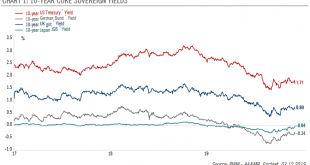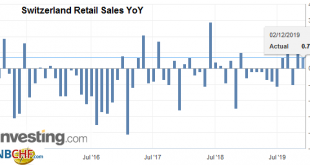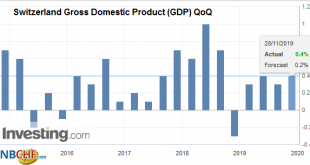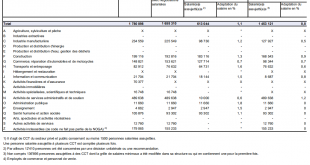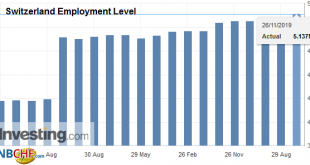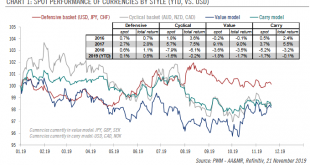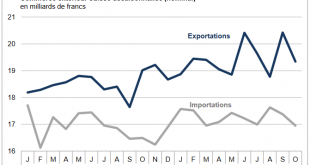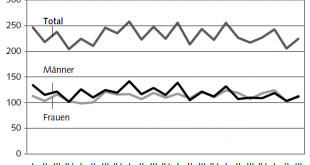Neutral US Treasuries. We expect the US 10-year yield to fall towards 1.3% in H1 as US growth falters and the US Federal Reserve starts signalling additional rate cuts. However, continued monetary easing and election promises (i.e. fiscal stimulus) could boost inflation expectations in H2, with the 10-year yield ending 2020 at around 1.6% in our central scenario. Overall, we expect a positive single-digit total return for 10-year Treasuries next year and a steepening...
Read More »Swiss Consumer Price Index in Novemeber 2019: -0.1 percent YoY, -0.1 percent MoM
03.12.2019 – The consumer price index (CPI) fell by 0.1% in November 2019 compared with the previous month, reaching 101.7 points (December 2015 = 100). Inflation was –0.1% compared with the same month of the previous year. These are the results of the Federal Statistical Office (FSO).The decrease of 0.1% compared with the previous month can be explained by several factors including falling prices for international package holidays and hotel accommodation. The prices...
Read More »Swiss Retail Sales, October 2019: +0.1 percent Nominal and +0.9 percent Real
02.12.2019 – Turnover adjusted for sales days and holidays rose in the retail sector by 0.1% in nominal terms in October 2019 compared with the previous year. Seasonally adjusted, nominal turnover rose by 0.9% compared with the previous month. These are provisional findings from the Federal Statistical Office (FSO). Real turnover adjusted for sales days and holidays rose in the retail sector by 0.7% in October 2019 compared with the previous year. Real growth takes...
Read More »Euro Area 2020 Macro Outlook
. After an estimated 1.2% in 2019, we expect GDP growth of 1.0% in the euro area in 2020. Country wise, we expect more manufacturing-intense countries to underperform more domestically driven ones. Thus, we project weak growth of 0.7% in Germany and 0.4% in Italy in 2020, while we expect France and Spain to remain relatively resilient, growing by 1.2% and 1.7%, respectively. Domestic demand, particularly household consumption, is expected to remain the main growth...
Read More »Switzerland GDP Q3 2019: +0.4 percent QoQ, +1.1 percent YoY
Switzerland’s GDP rose by 0.4% in the 3rd quarter of 2019, after increasing by 0.3% in the previous quarter. Exports of chemical and pharmaceutical products and energy were key contributing factors. In other areas, the impact of the subdued international environment was felt more strongly. The economic slowdown is being borne out on the whole. Switzerland Gross Domestic Product (GDP) QoQ, Q3 2019(see more posts on Switzerland Gross Domestic Product, ) Source:...
Read More »Swiss wage index 2019: Real and minimum wages increased by 1.1 percent and 0.8 percent respectively in 2019
26.11.2019 – The social partners signatory to Switzerland’s main collective labour agreements (CLA) agreed a nominal rise in real wages of 1.1% and a nominal rise in minimum wages of 0.8% for 2019. Real wages increased by 0.5% at collective level and by 0.6% at individual level. These are the some of the results of the wage agreements survey carried out by the Federal Statistical Office (FSO). . Download press release: Real and minimum wages increased by 1.1% and...
Read More »Employment Barometer in the Q3 2019: Employment higher than ever
26.11.2019 – Total employment rose in the third quarter by 1.3% compared with the same quarter a year earlier. At 5.137 million jobs it reached the highest level since the statistics began. In full-time equivalents, employment in the same period rose by 1.1%. The Swiss economy counted 6900 more vacancies than in the corresponding quarter of the previous year (+9.6%). The employment outlook indicator is indicating a downward trend (-0.2%) and difficulties in...
Read More »Currencies: do it with style
Our scenario of ongoing global growth moderation and elevated political uncertainties should, we believe, support defensive currencies. We consider a currency ‘defensive’ if it is likely to remain resilient should global risk appetite falter. Among major currencies, the US dollar, the Japanese yen and the Swiss franc are usually considered as defensive. Indeed, the structural current account surplus and large net foreign assets of both Japan and Switzerland make...
Read More »Swiss Trade Balance October 2019: exports fall but remain stable
We do not like Purchasing Power or Real Effective Exchange Rate (REER) as measurement for currencies. For us, the trade balance decides if a currency is overvalued. Only the trade balance can express productivity gains, while the REER assumes constant productivity in comparison to trade partners. Who has read Michael Pettis, knows that a rising trade surplus may also be caused by a higher savings rate while the trade partners decided to spend more. This is partially...
Read More »Swiss Labour Force Survey in 3rd quarter 2019: 0.3percent increase in number of employed persons; unemployment rate based on ILO definition rose to 4.6percent
14.11.2019 – The number of employed persons in Switzerland rose by 0.3% between the 3rd quarter 2018 and the 3rd quarter 2019. During the same period, the unemployment rate as defined by the International Labour Organisation (ILO) increased from 4.4% to 4.6%. The EU’s unemployment rate decreased from 6.5% to 6.2%. These are some of the results of the Swiss Labour Force Survey (SLFS). Download press release: 3rd quarter 2019: 0.3% increase in number of employed...
Read More » Swiss Economicblogs.org
Swiss Economicblogs.org

